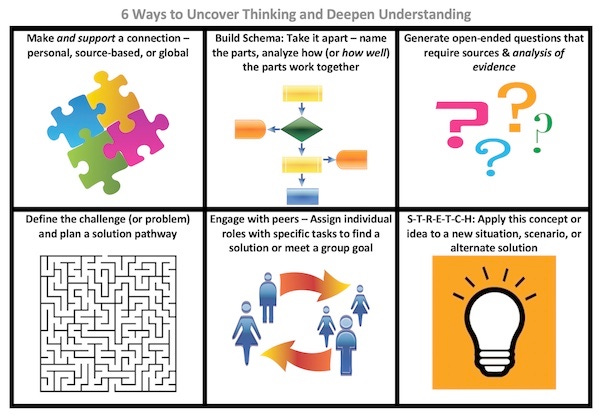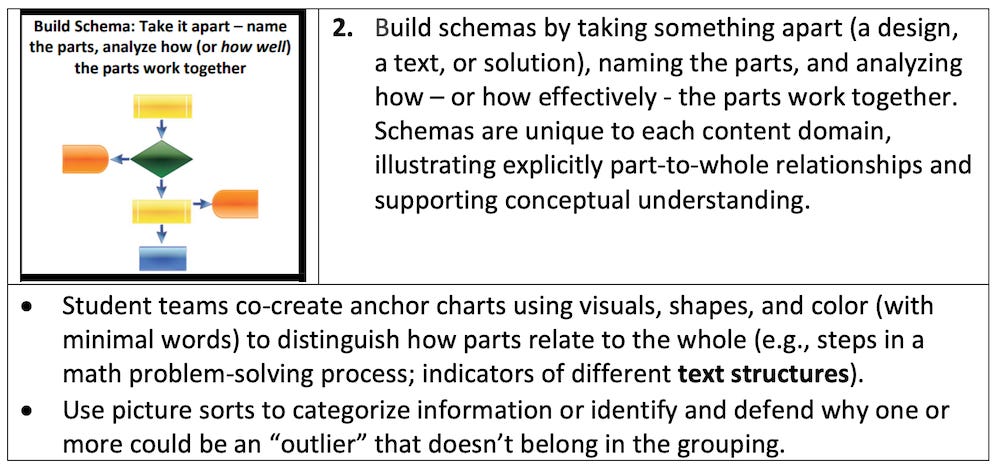ARTICLE: Deepen Thinking to Add True Rigor
How can you be sure your students are doing rigorous work AND thinking deeply? Dr. Karin Hess answers that question in our most popular article of 2023-24.
Dear paid subscribers: Thank you! You’re providing essential support that helps MiddleWeb.com continue our commitment to publish the voices of middle grades educators – and to update and curate our thousands of articles and reviews written for and by educators who support kids in grades 4-8.
If you are a free subscriber, we could really use your help; consider a paid subscription when you can. ($5 month; $50 year).
All our subscribers receive our free biweekly newsletter showcasing teaching and leading topics you care about. What follows here is one of the occasional full-text articles we share, plucked from a list of all-time popular posts.
★ MiddleWeb Substack Full-Text Article ★
6 Ways to Add True Rigor by Deepening Thinking
By Karin Hess
What does it look and sound like when your students are doing rigorous work and thinking deeply? Over the years I’ve heard a lot of misconceptions about rigor, such as “increasing rigor means giving students more or harder work to do.”
A misguided view of rigor can make learning inaccessible to many students who can think deeply. Teachers need to know how to set the stage to uncover their thinking and help them deepen their understanding.
Raising expectations is NOT as simple as assigning difficult texts to read or using higher-order verbs (e.g., analyze, synthesize) to describe what students are going to do during a lesson.
How Cognitive Rigor Works
Cognitive rigor is created by the interaction of three key factors: content complexity + cognitive engagement + the intended scope and depth of the learning activity.
1. Content Complexity: Complex concepts and strategies (e.g., concrete versus abstract ideas; literal versus figurative interpretations; practical applications versus theories) always require supports to increase access and engagement.
2. Cognitive Engagement: Engagement with the content (sometimes defined using Depth-of-Knowledge/DOK levels) describes how deeply we want students to apply their understanding to complete a task – from surface-level recall to conceptual understanding, problem solving, or in-depth extended thinking.
We know from brain research that emotional engagement precedes deeper cognitive engagement. When students first make personal connections to new content – “what do I already know about this topic?” or “how is this problem relevant to me/my world?” – doors to complex mental processing and problem-solving begin to open.
3. Scope and Depth: The scope of the planned learning or assessment activity influences the overall cognitive rigor, especially when multiple sources must be analyzed and interpreted or a complex product of learning is to be developed (e.g., research project, podcast, multimedia presentation).
Increasing rigor must go hand in hand with supports that help every student access the meaning of the content (a new strategy, concept, or theory) before they are asked to explain it, apply it, or analyze it.
Providing background knowledge related to a topic prior to introducing a complex text or breaking down a complex strategy into several steps are examples of strategically scaffolding complex content. Even adult learners benefit from scaffolding when tackling complex content!
Also see Karin’s MiddleWeb article:
How to Be Strategic with Scaffolding Strategies
6 Ways to Uncover Rigorous Thinking and Deepen Understanding
Teachers can elicit evidence of cognitive rigor by asking students to brainstorm possible solutions instead of asking for one correct solution; by using feedback to refine their performance, rather than telling students what to correct; or by having them practice using metacognitive skills while monitoring their own learning processes.
© Karin Hess (2018) Rigor By Design, Not Chance: Laying the Foundation for Deeper Learning. Underhill, VT: Educational Research in Action. Permission is given to use/reproduce only with full citation. www.karin-hess.com
I’ve identified six ways to move students’ thinking to deeper levels of understanding and created a “student-friendly” infographic of the six strategies (above). This can be printed as a poster or cut apart and used as task cards as metacognitive prompts when students are engaging in collaborative discourse or working through a complex challenge.
Some teachers print and use the cards to create cubes that can be rolled like dice to randomly select a prompt for small group discussions or reflective journaling.
The Strategy Tips to Share with Students
(click a graphic to enlarge – the resource links offer more information)
We create opportunities for cognitive engagement and deeper thinking when asking students to …
Resource: sketchnoting
Resource: text structures
Resource: Wonder Wall
Resource: Collaborative Inquiry Planning
Resource: peer conferencing or feedback worksheet
Resource: One pagers, ELA, math/science, social studies
Rigor in All the Right Places
When we know what rigorous thinking can look and sound like, we can help students to use many of these strategies in almost any lesson. If you’d like to explore these ideas in a seminar format, see my YouTube video Looking for Rigor in All the Right Places.
Also see Karin’s MiddleWeb article:
Five Metacognitive Tools to Reveal Hidden Learning
Dr. Karin Hess is the creator of the Hess Cognitive Rigor Matrices and the author of Rigor by Design, Not Chance: Deeper Thinking Through Actionable Instruction and Assessment (ASCD, 2023) and Deeper Competency-Based Learning: Making Equitable, Student-Centered, Sustainable Shifts (Corwin, 2020).
Karin is a former middle school teacher and school administrator. She is recognized internationally as a leader in applying cognitive rigor, depth of knowledge (DOK) and learning progressions to the development of state and school-based curriculum and assessment systems. She can be contacted through her website www.karin-hess.com, where teachers can find many helpful free resources.









